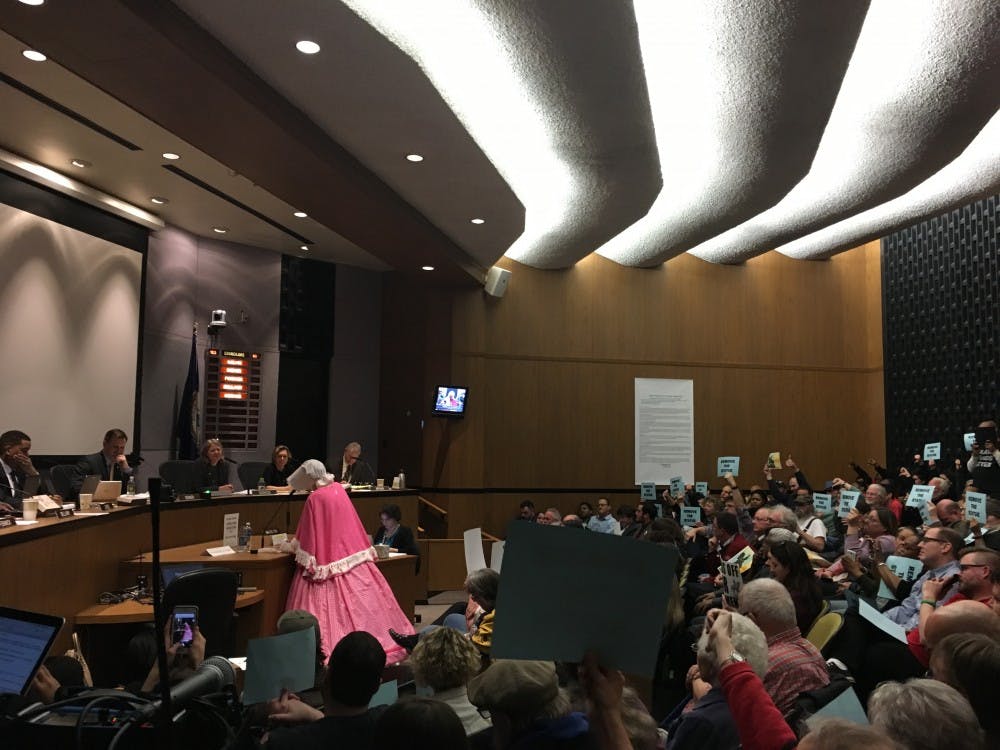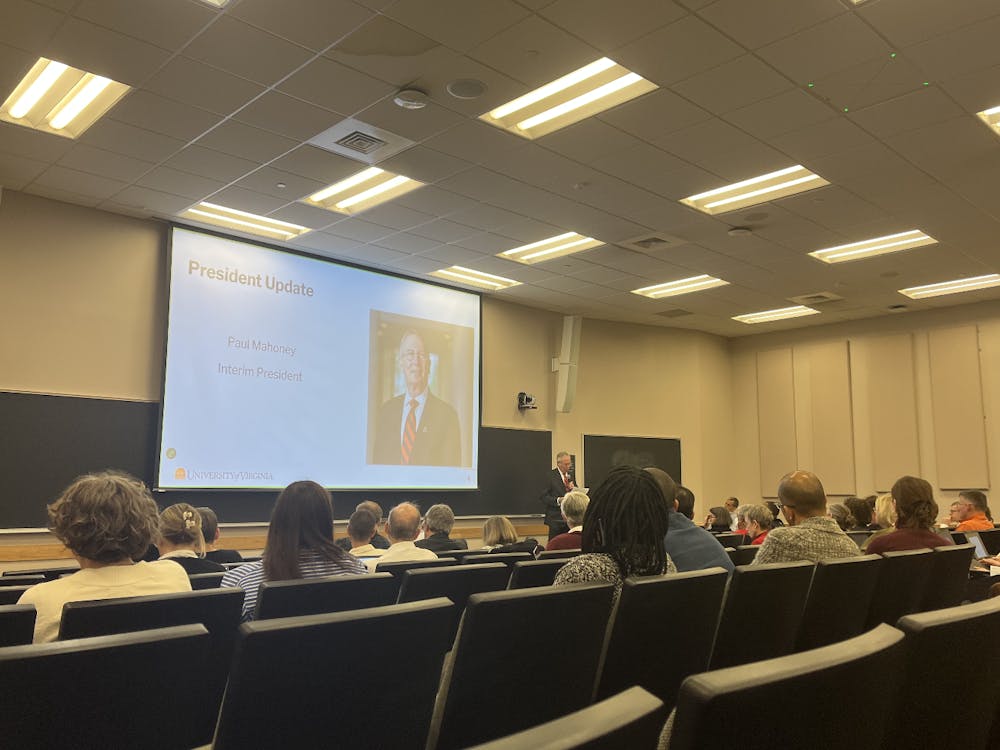Charlottesville City Council passed a motion Monday to remove the Confederate statue of Robert E. Lee from Lee Park. The decision passed with three votes in favor of the removal and two against.
Vice Mayor Wes Bellamy, and Councillors Kristin Szakos and Bob Fenwick, voted in favor of removing the statue from downtown Charlottesville while Mayor Mike Signer and Councilor Kathy Galvin voted against.
The resolution to the statue was first proposed last month at the Council meeting on Jan. 17. The vote ended in a 2-2 tie with Councilor Bob Fenwick abstaining.
The Council was presented with two options — remove the statue from the park and relocate it or contextualize the monument with its historical background and use it as a forum for discussion.
Over a hundred Charlottesville community members sat in on the meeting to convey their positions about the location of the statue, filling the meeting room and outside hallway.
Signer began the meeting with an expressed desire for members and attendees to maintain decorum and respect.
“We all have a stake in this city and in our commonwealth and our nation and we all have a right to feel safe and to feel hurt,” Signer said. “Even about the most difficult matters we should be able, at the very least, to disagree without being disagreeable. So I am asking everyone tonight to proceed in the spirit of civil and civic dialogue.”
The floor then opened to nine pre-registered speakers from the public to express their response to the issue.
The first speaker, Religious Studies Assoc. Prof. Jalane Schmidt, paralleled Charlottesville’s recent declaration of support for immigrant and refugee populations to a lack of empathy for refugees of past generations.
“My concern is the empathy gap that I perceive between the enthusiasm for welcoming current international refugees while the plight of previous generations of African-American refugees who fled our city receives much less fanfare,” Schmidt said.
Schmidt argued the statues of Civil War generals promote and perpetuate a false narrative of a lost cause and blur the memory of the suffering of the enslaved majority of Charlottesville.
Those who spoke in support of keeping the statue pointed toward maintaining the art of the statue as well as transforming its historical context and teaching all sides of history.
“Removing [the statues] would be a weak solution that uncourageously [sic] evades the more challenging question of how to learn from them and their original public settings,” former University Art History Prof. Malcolm Bell said. “By leaving them where they are we would be called upon to tell their story without resorting to the false narratives of the past.”
After the speeches from the community, Szakos formally introduced the motion on the floor to remove the statue of Robert E. Lee from Lee Park as well as to rename the park.
Galvin suggested a friendly amendment to separate the question of removing the statue and renaming the park to two separate motions. The amendment passed and the motion was reintroduced.
“Now therefore be it resolved that the city of Charlottesville shall remove the statue of Robert E. Lee from the park currently known as Lee Park and be it further resolved that we hereby direct staff to bring council a range of recommended options for moving forward with decisions on destination and design within 60 days for our consideration,” the motion read.
Each member then addressed their stance on the issue. The speeches were met with a variety of responses from the audience. Attendees were asking to simply raise their hand if they supported a statement or lower their thumbs in opposition.
Those who spoke out were warned and then asked to leave the room — resulting in the forced removal of one man by police officers present.
Szakos began with an argument for the removal of the statue in support of one’s neighbors and redressing historical grievances.
“I am convinced that this council is unanimous in feeling that these statues of fallen rebel commanders do not represent our interpretation of history or the way we should treat our neighbors,” Szakos said. “It may well be that with all the creative minds in our city, we could find a way to transform the message of the statue but I am convinced ... it would not really undo the harm that the statue’s presence would continue to inflict on us and our neighbors well into the future.”
Fenwick echoed Galvin’s sentiments, declaring his support for the statue’s removal after abstaining from the vote last month.
“There is not just one way, our way, to honor history, particularly at the expense of many of our neighbors,” Fenwick said. “There is not just one way to make a park vibrant and a center of community life.”
Fenwick acknowledged the varying, conflicting opinions of the community but pointed to the evening’s reflection of the democratic process.
“For some it will be a confusing night, a night when a vote is taken seemingly contrary to historical scholarship for some academics and professional historical preservationists,” Fenwick said. “It will also be a night of celebration of a governmental action of the people, by the people, and for the people. An active acknowledgment not of the majority but a strong, patient minority.”
Galvin was the first to express a dissenting opinion, pointing toward the critical historical dialogue keeping the statue could provide.
“I and others have argued that transforming the statue in place would be less costly, freeing us up funds and staff time for other causes that get at the systemic problems that were born out of slavery and Jim Crow,” Galvin said.
A report from the city’s Blue Ribbon Commission on Race, Memorials and Public Spaces included a preliminary estimate of $330,000 for removing the Lee statue.
Signer mirrored Galvin’s argument to maintain the statue and transform its message. Signer said the removal of the statue would be moving backward in history while retelling the story accurately would be progressive.
“To move forward, we must visibly and transparently push against the past,” Signer said. “We must see and defy these monuments to overcome what they mean.”
Signer’s speech was not received favorably by all members of the audience. One attendee feigned a coughing attack and said it was due to levels of “white supremacy.” Signer paused his speech and, noting the woman did not appear ill, acknowledged her display of civil disobedience.
Bellamy concluded the speeches by outlining various ways the city is seeking to address race and equality issues focusing on housing, education and community programs.
He concluded with his support of the removal of the statue and emphasized the importance of the community to look past disagreements and work together.
“It is okay to disagree, it is okay to not understand each other on the surface,” Bellamy said. “If you agree that the City of Charlottesville must move forward in the way in which we interact with each other … the way in which we listen and value each other, then you, my friends, regardless of your skin color, regardless of your position on this issue, you are not my enemy.”
Although the Council was divided 3-2 in their decision to remove the statue, they voted unanimously in favor of renaming Lee Park.







